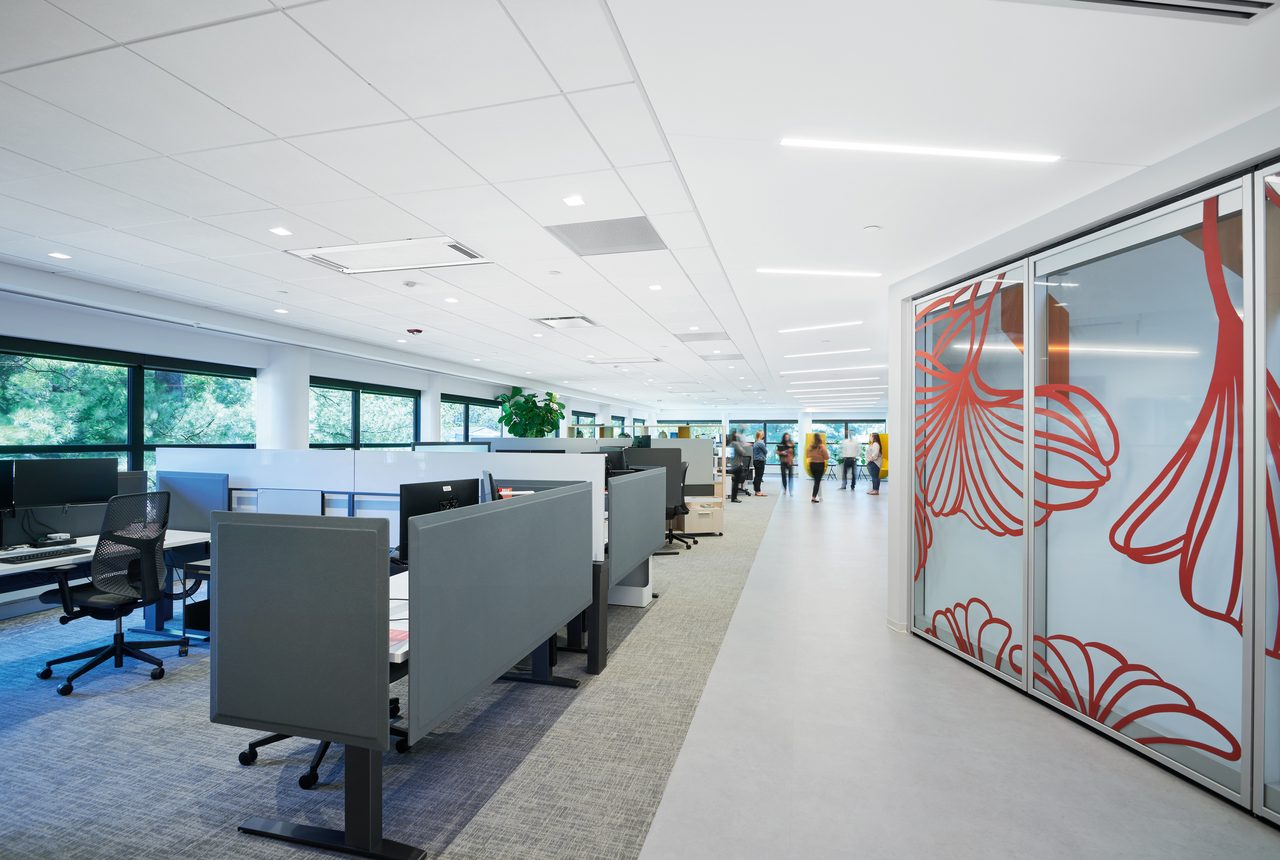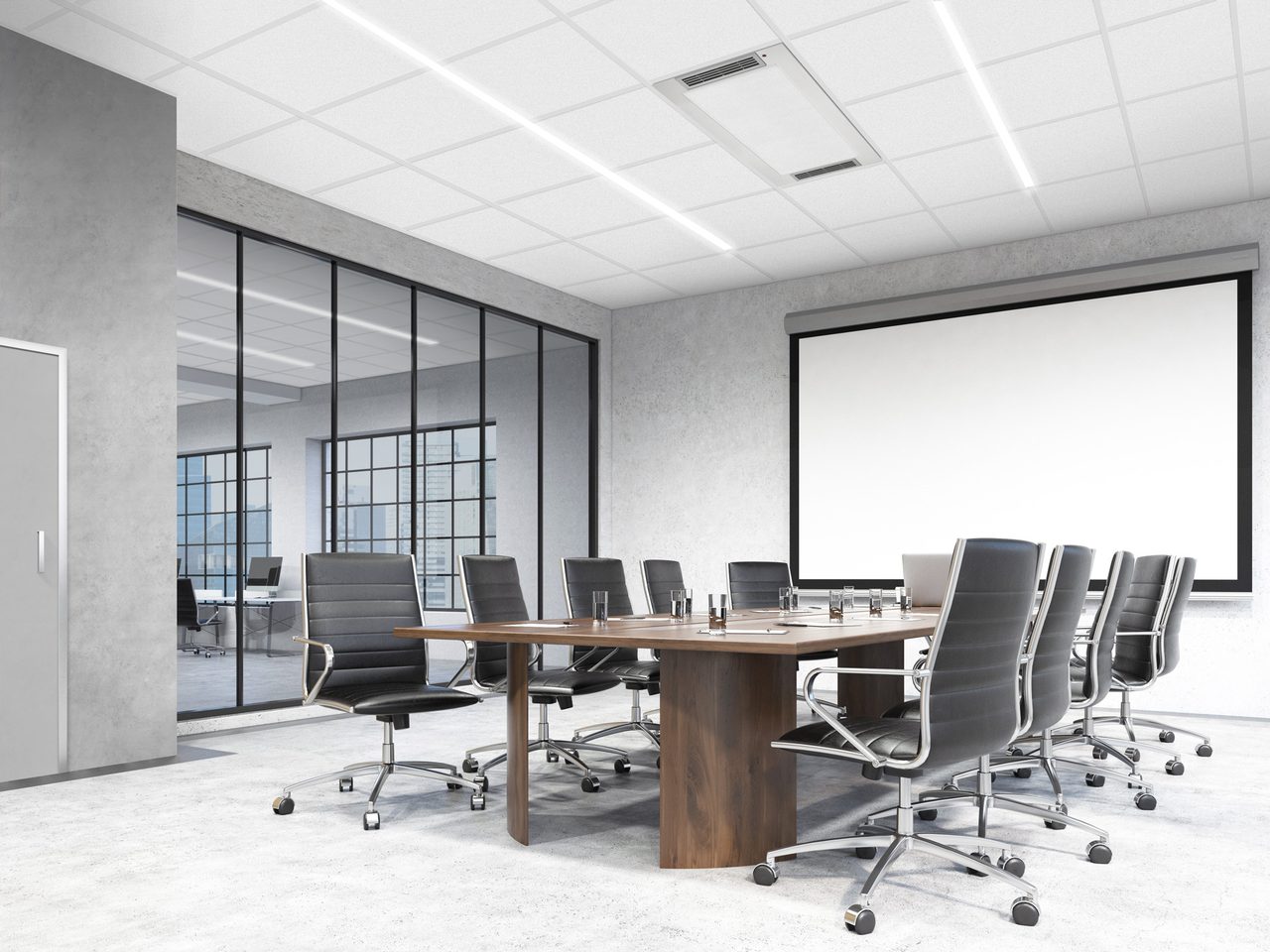DESIGNING HEALTHIER ENVIRONMENTS
A Healthy Return to the Office Requires an Ongoing Focus on Indoor Air Quality
New Suspended Ceiling Technologies Can Help Limit Airborne Transmission of Viruses and Germs

Armstrong AirAssure ceiling panels easily retrofit into existing grid systems, incorporate a gasket in their design, and have been proven to increase the effectiveness of in-ceiling air filtration by up to 40%.
THE RISK of contracting COVID has changed, even for those fully vaccinated, and has spurred heightened awareness of how to stay healthy indoors, with many workers nervous about returning to their desks.
A critical part of re-entry is assurance that employers are providing a safe, healthy environment with improved indoor air quality. To that end, employers need to take precautions to comply with guidelines to minimize exposure to not only COVID-19 but also the airborne transmission of other viruses and germs long present in indoor environments as well.
Science has learned much about the spread of viruses over the past year and there are some clear evidence-based steps that can be taken to protect workers. Since the coronavirus and other pathogens are spread via tiny airborne droplets, one such step is an upgrade in the ventilation and filtration systems before bringing workers back. It is important for employers to make decisions now that will benefit the safety and health of workspaces into the future.
Office Environment Concerns
According to the U.S. Centers for Disease Control and Prevention (CDC), studies have shown that transmission of COVID-19 from inhalation of the virus in the air can occur at distances greater than six feet. In addition, particles from an infected person can move throughout an entire room or indoor space. The particles can also linger in the air after a person has left the room. They can remain airborne for hours in some cases.
Though the risk of infection by breathing in particles carrying the virus generally decreases with distance from infected people and with time, some circumstances increase the risk of infection:
- Being indoors rather than outdoors, particularly in indoor environments where ventilation with outside air is inadequate
- Crowded or shared spaces
- Activities like speaking loudly, singing, or exercising
- Prolonged time of exposure (e.g., longer than a few minutes)
To combat the potential spread of viruses like COVID-19 and other airborne pathogens now and in the future, safeguards need to be increased not just for COVID but also for the long term to meet occupants’ ongoing needs for indoor health and a sense of well-being.
Today’s Office Environment
With a better understanding of today’s workplace, the challenges facing a return to the office are clear. Research from the World Health Organization (WHO) suggests heavily populated environments with poor or insufficient air flow raise infection rates. The WHO further encourages good ventilation in all closed settings.
Similarly, in May 2020, the CDC updated its “Guidance for Businesses and Employers Responding to Coronavirus Disease 2019” suggesting employers seeking to resume normal business operations improve the building’s ventilation system.
HVAC Recommendations
In providing guidance on healthy workplace procedures for the return to offices, the CDC cites HVAC airflow recommendations from the American Society of Heating, Refrigerating and Air-Conditioning Engineers (ASHRAE). In its April 2020 “Position Document on Infectious Aerosols,” ASHRAE states while ventilation systems cannot address all aspects of infectious control, “changes to building operations, including the operation of heating, ventilating, and air-conditioning systems, can reduce airborne exposures.”
The document lists several recommendations employers should consider to reduce occupant exposure to infectious aerosols. Among them are strategies to improve ventilation through dilution, airflow patterns, filtration, and pressurization.

The VidaShield UV24 In-Ceiling Air Purification System from Armstrong helps neutralize harmful airborne pathogens using patented UV-C ultraviolet air cleaning technology to continuously reduce levels of viruses, bacteria, and fungi in a room’s air.
Leakage Control
An additional effective strategy is utilizing suspended ceiling technologies in combination with improved filtration. For example, specially engineered suspended ceilings are a proven technology in medical patient rooms, clean rooms, and labs to help prevent the spread of contaminants. Today, suspended ceiling panels are available that incorporate a gasket in their design. The gasket is placed between the ceiling tile and grid to form a tight seal and help contain and control airflow and the potential spread of infectious particles into the plenum and other areas of the building.
By helping to reduce air leaks, the tighter seal can also increase the efficiency of HVAC filtration. Increasing the effectiveness of HVAC systems could be one of the keys to controlling the transmission of viruses like COVID-19 and other infectious p2articles. An efficient system allows more contaminants to be exhausted into filters that clean the air of viruses, germs, and bacteria.
An added challenge today is the trend of higher ceilings that expose duct and pipe work.
The incorporation of a suspended ceiling reduces ceiling height and thus the volume of air needing to be exhausted. A metric used to measure the amount of air entering and exiting a room is air changes per hour (ACH). Installation of a suspended ceiling increases ACH and lowers the time it takes to clear a space of airborne contaminants.
Armstrong Ceiling Solutions
To help ensure healthier environments that are adaptive and resilient for the long term, Armstrong Ceiling & Wall Solutions offers a range of suspended ceiling options and new ceiling technologies. These products fall under the Armstrong 24/7 Defend™ platform. They include the CleanAssure™ portfolio of ceilings, walls and suspension systems that meet CDC recommendations for cleaning and disinfecting and the AirAssure™ family of ceiling solutions. Both easily retrofit into existing grids. Most are also in the Sustain® portfolio, meeting the most stringent industry sustainability compliance standards today.
The air purifier panels use ultraviolet light to deactivate pathogens. Third-party test results show the system neutralizes 97% of infectious pathogens in aerosols during the first pass of air through the system.
The CleanAssure family of products can be cleaned by wiping, spraying, or fogging to make spaces cleaner and healthier. AirAssure panels incorporate a gasket and improve indoor air quality by reducing airflow leakage through the ceiling plane. The panels have been proven to increase the effectiveness of in-ceiling air filtration by up to 40%.
Armstrong also offers the VidaShield UV24™ air purification system that integrates with its ceiling systems. The air purifier panels use ultraviolet light to deactivate pathogens. Third-party test results show the system neutralizes 97% of infectious pathogens in aerosols during the first pass of air through the system. Each unit provides room-based continuous air cleaning from the ceiling plane through a patented, shielded UV-C chamber, and increases the number of air changes in a space.
Summary
As the nation’s economy rebounds and workers return to all types of indoor spaces, ensuring a safe and healthy environment is critical now and for the long term. The confidence of knowing systems and facilities have been implemented or upgraded to potentially reduce the transmission of COVID-19 or other viruses, bacteria, and germs is paramount to increasing a sense of occupant well-being before the return of many to their traditional spaces.
For More Information
Much of the information above is drawn from a white paper prepared by the Thompson Research Group illustrating how air quality and suspended ceiling technologies can play an important role as stand-alone solutions or in conjunction with other products to reduce the spread of infectious aerosols. To view the entire white paper and learn how to create healthier spaces, visit armstrongceilings.com/healthyspaces.